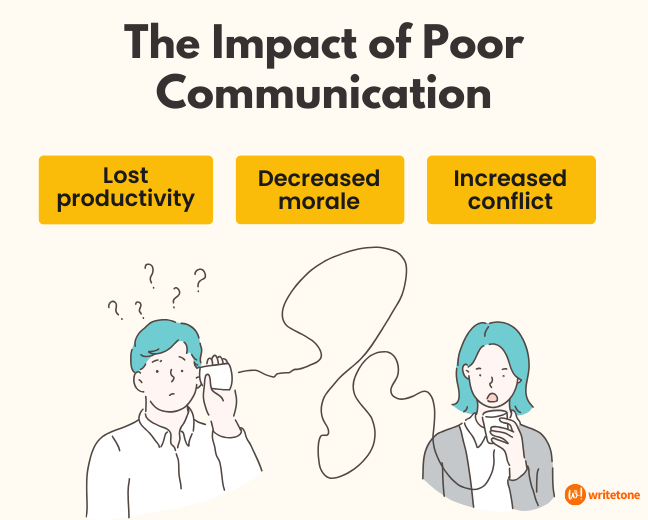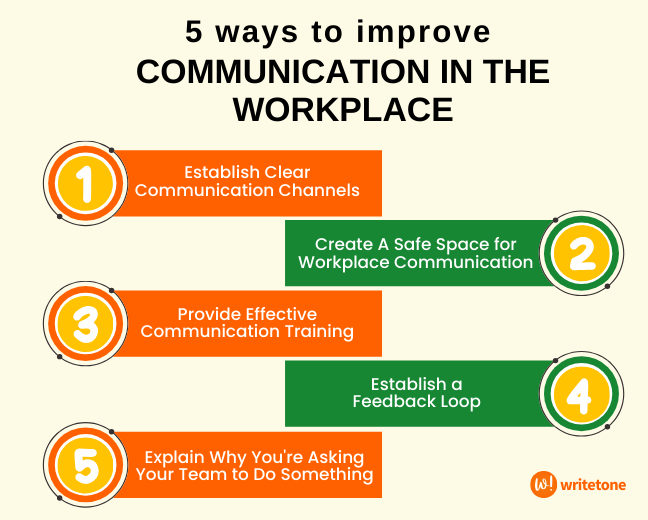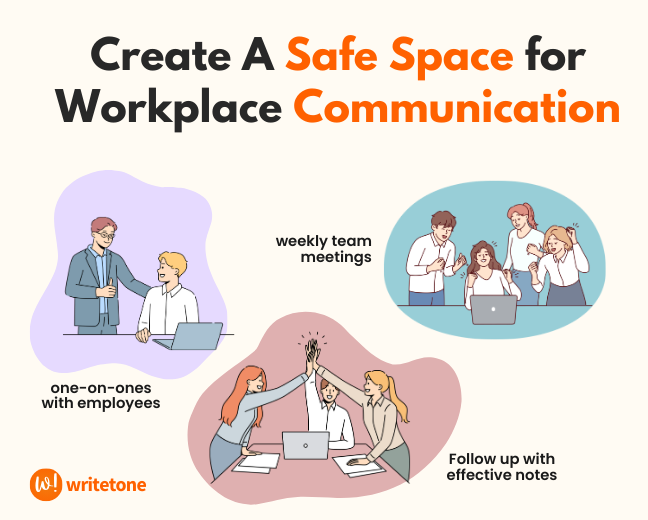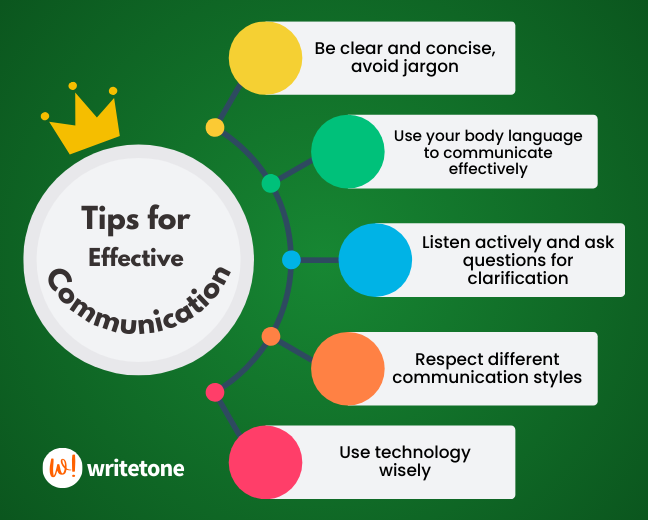5 Ways to Improve Communication in The Workplace

Communication is the lifeblood of any organization. It's how we share information, build relationships, and achieve goals. But when communication breaks down, it can lead to misunderstandings, frustration, and conflict.
What is good communication in the workplace?


Good communication means being able to share information clearly, concisely, and effectively. It also means being able to listen to what others have to say and understand their point of view.
Improving communication in the workplace is an ongoing process that requires effort from everyone involved. But the benefits of good communication are well worth the effort.
The Impact of Poor Communication

Poor communication can have a significant negative impact on an organization. It can lead to:
• Lost productivity:
When employees are not clear about their tasks or expectations, they are more likely to make mistakes and waste time.
• Decreased morale:
When employees feel like their voices are not being heard or that they are not being respected, their morale will suffer. This can lead to absenteeism, presenteeism, and high turnover rates.
• Increased conflict:
When communication is unclear or ineffective, it can lead to misunderstandings and disagreements. These conflicts can escalate and damage relationships, creating a toxic work environment.
Fortunately, there are a number of things that can be done to improve communication in the workplace.
Here are five ways to improve communication in the workplace:

Establish Clear Communication Channels
In today's digital age, there are many different ways to communicate. It's important to make sure that these channels are clear and organized so that everyone is on the same page. This could involve using:

• Messaging apps
like Slack or Microsoft Teams for quick, informal conversations
• Project management platforms
like Asana or Trello for tracking tasks and deadlines
• Email systems
for formal communication and record-keeping
These tools can help you create a structured framework for exchanging information. This will reduce the chances of information silos and keep the entire team on the same wavelength.
Encourage team to use AI writing tools like Writetone to fine-tune their communication. When crafting messages, it's important to be clear, concise, and professional. AI writing tools like Writetone can help you achieve this by:

• Paraphrasing
your text to ensure your ideas are conveyed in the most understandable way.
• Summarizing
lengthy documents to save time and enhance clarity.
• Providing grammar suggestions
to polish your writing and eliminate errors.
Create A Safe Space for Workplace Communication
A workplace where people can talk openly is a place where people can come up with new ideas and work together. Leaders need to make sure that employees feel like they can say what they think. They need to listen to what people say, respect different opinions, and value everyone's input.

1. Make time for regular one-on-ones with employees.
One-on-ones are a great way to check in with employees, discuss their progress, and provide feedback.
They also give employees a chance to share their concerns and ask questions. One-on-ones should be scheduled on a regular basis.
2. Schedule weekly team meetings.
Team meetings are a forum for sharing information, discussing projects, and making decisions.
They also help to build team spirit and camaraderie.
3. Follow up with effective notes and clear job expectations.
After meetings or discussions, it is important to follow up with written notes and clear job expectations. This will help to ensure that everyone is on the same page.
Provide Effective Communication Training
Not everyone is born with great communication skills, but they can be learned. Communication training programs give employees the tools they need to express their ideas, resolve conflicts, and give constructive feedback. Providing communication training to your employees can:
• Enhance their ability to express ideas clearly and concisely.
• Equip them with the tools to resolve conflicts effectively.
• Empower them to provide constructive feedback.
• Build a workforce that communicates well and collaborates effectively.
Establish a Feedback Loop

Continuous improvement relies on feedback. Implementing a feedback loop where employees can provide insights on communication processes helps to understand what works and what doesn't. It will also help to make sure that your communication strategies are meeting the needs of your employees. Implementing a feedback loop allows you to gather insights from employees:
• Conduct surveys or interviews to understand their communication experiences.
• Observe employees in their work environment to identify communication challenges.
• Analyze project feedback to identify areas for improvement.
Once you have collected feedback, it is important to take action to address any concerns that have been raised. This may involve making changes to your communication policies or procedures. It is also important to communicate with your employees about the changes that you have made. This will help to ensure that they are aware of the new policies and procedures and that they understand how they will impact their work.
Explain Why You're Asking Your Team to Do Something.
When you ask your team to do something, take the time to explain why it is important.
For Example:if you're asking your team to work on a new project, you could explain that the project is important because it will help the company to grow and succeed. You could also share some of your goals for the project and how you think the team can achieve them.This will help them to understand the bigger picture and by taking the time to explain why you're asking your team to do something; you're showing that you value their input and that you're confident in their ability to get the job done. This will help to build trust and motivation, which are essential for a successful team.
Tips for Effective Communication

• Be clear and concise, avoiding jargon.
• Use your body language to communicate effectively.
• Listen actively and ask questions for clarification.
• Respect different communication styles.
• Use technology wisely, such as project management software, instant messaging, and video conferencing.
Conclusion
Effective communication is essential for any organization that wants to be successful. By implementing the strategies in this blog post, you can create a workplace where communication is open, honest, and effective. This will lead to a more productive, collaborative, and successful organization.